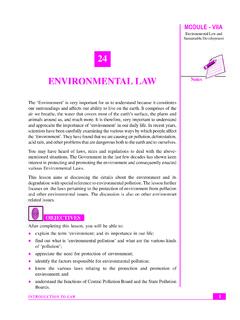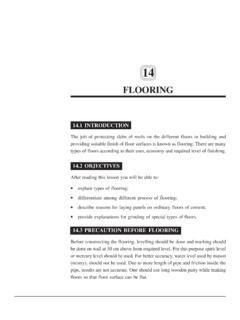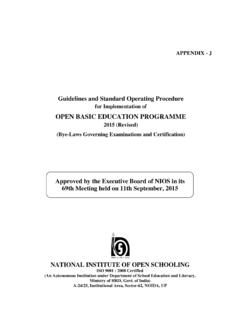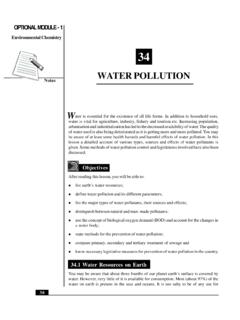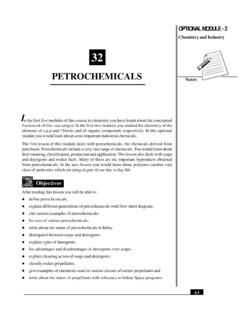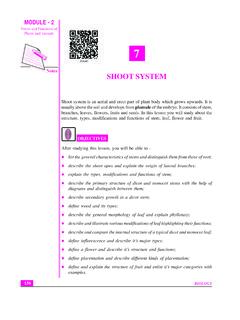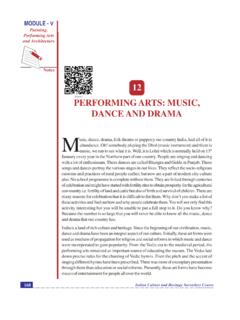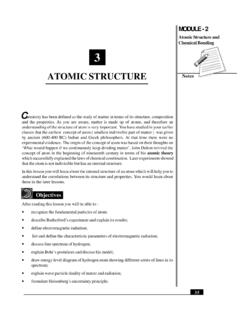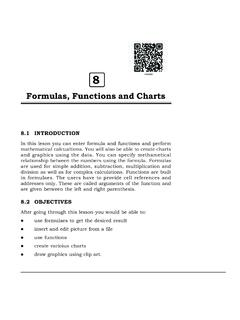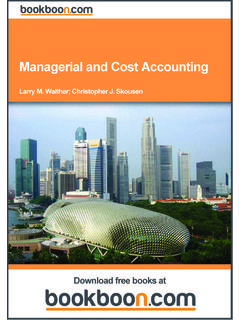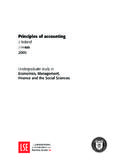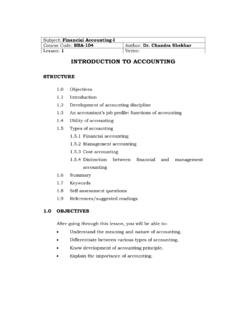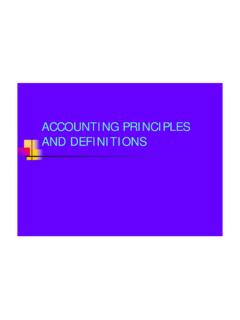Transcription of ACCOUNTING - AN INTRODUCTION Notes
1 3 NotesMODULE - 1 Basic AccountingACCOUNTANCY1 ACCOUNTING - AN INTRODUCTIONW henever your mother asks you to go to the nearby grocery store to buy items of dailyuse like match box, candle stick, soap cake, coffee, spices etc. you need not pay forthese items immediately. When you buy these items, the store owner immediately opensthe page of a note book on which your father s name is written. He records the valueof items purchased. At the end of the month, your father goes to him. He again opensthe same page tells the total amount to be paid and records when your father makes thepayment.
2 In a similar manner, he keeps the record of other customers also. Wheneverhe gets commodities from suppliers he records the same and also records the paymenthe makes to them. Similarly, every business small or big, sole proprietor or a firmkeeps the record of the business transactions. Have you ever thought why do theykeep record of business transactions? If they do not keep the record how will theyknow how much, when and to whom they have to make payments or from whom, howmuch and when they have to receive payments or what they have earned after a particularperiod and so on.
3 Recording of transactions by a businessman in proper books and ina systematic manner is known as ACCOUNTING . In this lesson you will learn about this studying this lesson you will be able to explain the meaning of Book-Keeping; state the meaning and nature of ACCOUNTING ; distinguish between book keeping and ACCOUNTING ; explain the advantages & limitations of ACCOUNTING ; explain the branches of ACCOUNTING ;OBJECTIVES4 NotesMODULE - 1 Basic AccountingACCOUNTANCY state the functions and objectives of financial ACCOUNTING ; explain ACCOUNTING as an information system for decision making by the interestedusers and explain various ACCOUNTING terms.
4 BOOK KEEPING AND ACCOUNTINGA business undertakes number of transactions. Can you estimate the number oftransactions a business undertakes? It depends upon the size of a business entity. Everyday business transactions may be around hundreds/thousands. Can a businessmanremember all these transactions in every respect? Not at all. So it becomes necessaryto record these business transactions in details and in a systematic manner. Recordingof business transactions in a systematic manner in the books of account is called book-keeping. Book-Keeping is concerned with recording of financial data.
5 This may bedefined as. The art of keeping a permanent record of business transactions isbook-keepng .From books of accounts important details such as total sales, total purchases, totalcash receipts, total payments, etc. may be ascertained. As you know the main objectiveof business is to earn profits. In order to ascertain the profit earned during a period,mere recording of business transactions is not enough. ACCOUNTING involves not onlybook keeping but also many other activities. In 1941, the American Institute of CertifiedPublic Accountants (AICPA) defined ACCOUNTING as The art of recording, classifying, summarising, analysing andinterpreting the business transactions systematically and communicatingbusiness results to interested users in ACCOUNTING ACCOUNTING is identified with a system of recording of business transactions that createeconomic information about business enterprises to facilitate decision making.
6 Thefunction of ACCOUNTING is to provide quantitative information, primarily financial in nature,about economic entities, that is intended to be useful in making economic American ACCOUNTING Association defined ACCOUNTING as : It is the process of identifying, measuring, recording and communicating therequired information relating to the economic events of an organisation to theinterested users of such - An Introduction5 NotesMODULE - 1 Basic AccountingACCOUNTANCYIn order to appreciate the nature of ACCOUNTING it is necessary to understand the followingrelevant aspects of the definition of ACCOUNTING :zEconomic events : It is the occurring of the consequence to a business organisationwhich consists of transactions that are measurable in monetary terms.
7 Purchase ofa Machinery, installing and keeping it ready for manufacturing is an economic eventwhich consists of a number of financial transactions. These transactions are (a)buying the machine, (b) transporting the same, (c) preparing the site for its installationand (d) incurring expenditure on installing the , Measurement, Recording and Communication :Identification implies determining what transactions are to be recorded itemsof financial character are to be recorded. For example, goods purchased for cashor on credit will be recorded. Items of non-financial character such as changes inmanagerial policies, etc.
8 Are not recorded in the books of means quantification of business transactions into financial termsby using monetary unit. If an event cannot be quantified in monetary terms, it is notconsidered fit for recording in the books of the firm. That is why important itemslike appointment, signing of contracts, etc. are not shown in the books of : Having identified and measured the economic events in financial terms,these are recorded in the books of accounts in monetary terms date wise. Therecording of the business transactions is done in such a manner that the necessaryfinancial information is summarized according to well established : The economic events are identified, measured and recorded insuch a manner that the necessary relevant information is generated and communicatedin a certain form to the management and other internal and external users ofinformation.
9 The financial information is regularly communicated through : refers to a business enterprise whether for profit or not for users of information. Many users need financial information to makeimportant decisions. These users can be investors, creditors, labour unions, TradeAssociations, - An Introduction6 NotesMODULE - 1 Basic AccountingACCOUNTANCYE volution of AccountingAs per Indian mythology Chitra Gupta is responsible for maintaining accountsin God s book on Arthashasthra written by Kautilya who was a minister in ChandraGupta s kingdom twenty three centuries ago mentions about the accountingpractices in India.
10 It describes how ACCOUNTING records have to be China and in Egypt ACCOUNTING was used for maintaining revenue records ofthe government book on Arithmetica Geometrica, Proportion at Proportionality(Review of Arithmetic and Geometric proportion) by an Italian Luca Pacioli isconsidered as the first authentic book on double entry book keeping. In hisbook he used the present day popular terms of ACCOUNTING Debit (Dr.) andCredit (Cr). He also discussed the details of memorandum, journal, ledger andspecialised ACCOUNTING procedures. He also stated that, all entries have to bedouble entries, if you make one creditor you must make some process can be summarised asAccounting ProcessDifference between book keeping and ACCOUNTING .
